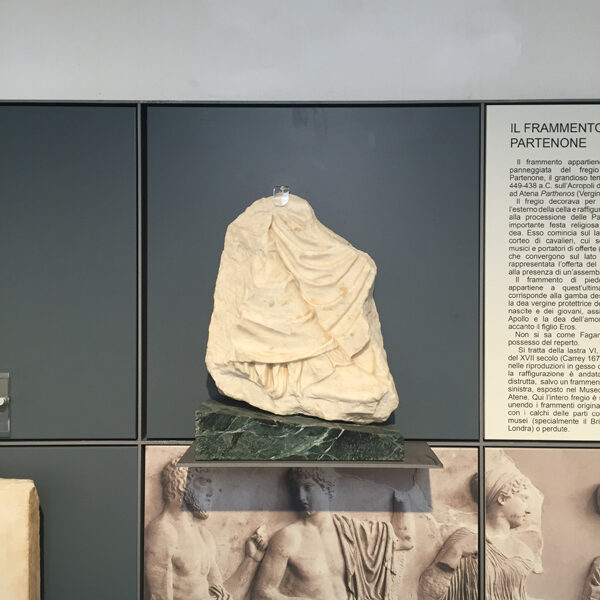When John Keats first saw the Parthenon frieze he was moved by his encounter with the ancients, marvelling at a “still unravish'd bride of quietness” whose legend haunted the shape of deities or mortals, or both, and left the fragile Romantic poet in ecstatic bewilderment: “What men or gods are these?”
The frieze which captured the passion and glory of the Panathenaic procession in Ancient Athens is now divided essentially between Athens and London courtesy of the notorious exploits of Lord Elgin. There are, however, several fragments in other museums and one of those pieces, from the East Frieze, is finally coming home.


The East Parthenon Frieze depicts the culmination of the procession where mortals and the Gods are drawn closer together. One of the segments of this sculptured frieze, known as Slab no. VI, features a number of seated deities, including Poseidon, Apollo, his sister Artemis and Aphrodite.
Artemis has placed her hand on Aphrodite's arm and is seemingly pointing towards the procession. Aphrodite’s and Artemis’ legs overlap although the sculptural ensemble is interrupted because a fragment, depicting part of the goddess Artemis’ foot and elaborate tunic, is in the Museo Archeologico Antonino Salinas in Palermo, Italy whilst the balance of the surviving segments of this panel are divided between the Acropolis Museum and the British Museum.
The Palermo fragment was ‘acquired’ by the Irish amateur archaeologist and painter Robert Fagan who had been made British Consul General in Sicily and Malta in 1809. It is not known exactly how he came to be in possession of the Parthenon fragment but it may have been given by Elgin himself to his compatriot British consul whilst passing through Sicily. After his death by suicide in 1816 (ironically the same year that the Elgin Marbles were acquired by the British government and transferred to the British Museum) Fagan’s widow donated the piece to the Vatican Museum and eventually it made its way into the collection of the Archaeological Museum in Palermo.
Greece and Italy have been discussing a loan of the Palermo fragment for almost twenty years.
In 2002 the Italian President Carlo Azeglio Ciampi supported the initiative to return the fragment but met considerable resistance from the museum itself which regarded the idea of return as an “anti-cultural” move that would impoverish the museum and deprive it of a piece which had become part of its history and identity. It was as though the Palermo museum was reading from the British Museum playbook.
Dr. Dorothy King, in her book “The Elgin Marbles” (published in 2006) recounts that at the time it was (wrongly) considered that the foot belonged to Aphrodite’s daughter, Peitho who was the goddess of persuasion and seduction and naturally the art of assuaging the fragment’s return was considered by some as an omen. King added (probably echoing what the British Museum would have been thinking) that had the piece been returned to Athens this would have set a precedent.
As it turned out, in September 2008 the fragment was sent to the New Acropolis Museum (which was to open in the following year) after more negotiations. The Greek President Karolos Papoulias thanked his Italian counterpart, Giorgio Napolitano, who had presented the Greek authorities with the fragment, stressing the symbolism inherent in the gesture in the wider context of Greece’s campaign for the return of the Parthenon Marbles from the British Museum.

The then Culture Minister Michalis Liapis also said the loan from Palermo was a boost to Greece's campaign to reunite all the Parthenon works at the new museum at the foot of the Acropolis, emphasising that the “positive responses we received in our international efforts encourage us to continue until we have achieved our target.”

However, the Palermo fragment returned to Sicily in 2010.
But the symbolism in procuring a long-term loan of the Parthenon fragment from Palermo was not lost on the Greeks. Finally, communications in earnest began in January 2021 between the Regional Government of Sicily and the Greek Minister of Culture and Sports, Dr Lina Mendoni, as well as between the two museums, to bring this to fruition.
The proposed arrangement is for a long term loan for at least eight years with the ability to renew the loan. In return, Greece will reciprocate with the loan of a headless statue of Athena and a geometric vase, each for four years, to be followed by other rare exhibits on a rotating basis.
The return is significant.
For a start, it will be an exemplar of enlightened curatorial and museum co-operation between countries and museums and will remind the world that Greece has made similar overtures to the British authorities for the return of the Elgin collection in exchange for a recurring loan of Classical Greek antiquities that have never before left Greece.
The reunification of the Palermo fragment is also significant at another level.
There are other fragments in museums throughout Europe, including the Louvre, the Vatican, the Museum of Art History in Vienna and the National Museum of Copenhagen. It is widely thought that in the past the British Museum has quietly pressured these museums not to yield to any Greek request for the return of those fragments for the obvious reason that it would cast the Trustees in Bloomsbury in a bad light.
One can only hope that the reunification of the gods of the Parthenon Frieze will not end here.
George Vardas is the Co-Vice Chair of the Australian Parthenon Association and Co-Founder of Acropolis Research Group.
Read also: The Magic of Philhellenism: In Conversation with Stephen Fry


